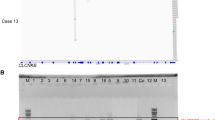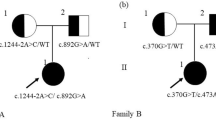Abstract
Purpose
Analyze the genotype of 42 Chinese patients with Bartter syndrome type 3 (BS3) and investigate their correlation between genotype and phenotype.
Methods
Identify CLCNKB gene variants by the next-generation sequencing and the multiplex ligation-dependent probe amplification (MLPA), and then evaluate their mutation effects according to 2015 American College of Medical Genetics and Genomics (ACMG) standards and guidelines.
Results
Thirty-six different variants in CLCNKB gene, including 13 novel ones, were found. The whole gene deletion of CLCNKB gene was the most frequent mutation (40%), and the rate of large deletions is up to 55%. Among 36 variants, six (c.1244T>A, c.1468G>A, c.849_851delCTT, c.359G>T, c.1052G>T, and c.1309G>A) and three (c.228A>C, c.1294_1295TA>CT, and c.1333T>G) variants were classified as “likely pathogenic variants” and “variants with uncertain significance (VUS),” respectively. The other 27 variants were classified as “pathogenic variants”. The most common symptoms included: growth retardation (38/42), polydipsia and polyuria (35/42), constipation (31/42), and vomiting (27/42). All patients presented with hypokalemia, hypochloremia, and metabolic alkalosis. The genotype and phenotype association study revealed that who had mutations probably resulting in complete loss of function of both alleles might have severer phenotype. After the treatment that based on indomethacin and potassium chloride, most patients could achieve obvious recovery of growth rate and restoration of hypokalemia.
Conclusions
The present study have found 36 variants of CLCNKB gene, including 13 novel ones, which enrich the human gene mutation database and provide valuable references to diagnosis, treatment, and the genetic counseling of Chinese population.


Similar content being viewed by others
References
S.C. Hebert, Bartter syndrome. Curr. Opin. Nephrol. Hypertens. 12(5), 527–532 (2003)
T.D.S. Cunha, I.P. Heilberg, Bartter syndrome: causes, diagnosis, and treatment. Int. J. Nephrol. Renovasc. Dis. 11, 291–301 (2018)
K. Brochard, O. Boyer, A. Blanchard, C. Loirat, P. Niaudet, M.A. Macher, G. Deschenes, A. Bensman, S. Decramer, P. Cochat, D. Morin, F. Broux, M. Caillez, C. Guyot, R. Novo, X. Jeunemaitre, R. Vargas-Poussou, Phenotype-genotype correlation in antenatal and neonatal variants of Bartter syndrome. Nephrol. Dial. Transplant. 24(5), 1455–1464 (2009)
K. Laghmani, B.B. Beck, S.S. Yang, E. Seaayfan, A. Wenzel, B. Reusch, H. Vitzthum, D. Priem, S. Demaretz, K. Bergmann, L.K. Duin, H. Gobel, C. Mache, H. Thiele, M.P. Bartram, C. Dombret, J. Altmuller, P. Nurnberg, T. Benzing, E. Levtchenko, H.W. Seyberth, G. Klaus, G. Yigit, S.H. Lin, A. Timmer, T.J. de Koning, S.A. Scherjon, K.P. Schlingmann, M.J. Bertrand, M.M. Rinschen, Ode Backer, M. Konrad, M. Komhoff, Polyhydramnios, transient antenatal Bartter’s syndrome, and MAGED2 mutations. N. Engl. J. Med. 374(19), 1853–1863 (2016)
R. Vargas-Poussou, C. Huang, P. Hulin, P. Houillier, X. Jeunemaitre, M. Paillard, G. Planelles, M. Dechaux, R.T. Miller, C. Antignac, Functional characterization of a calcium-sensing receptor mutation in severe autosomal dominant hypocalcemia with a Bartter-like syndrome. J. Am. Soc. Nephrol. 13(9), 2259–2266 (2002)
E. Seys, O. Andrini, M. Keck, L. Mansour-Hendili, P.Y. Courand, C. Simian, G. Deschenes, T. Kwon, A. Bertholet-Thomas, G. Bobrie, J.S. Borde, G. Bourdat-Michel, S. Decramer, M. Cailliez, P. Krug, P. Cozette, J.D. Delbet, L. Dubourg, D. Chaveau, M. Fila, N. Jourde-Chiche, B. Knebelmann, M.P. Lavocat, S. Lemoine, D. Djeddi, B. Llanas, F. Louillet, E. Merieau, M. Mileva, L. Mota-Vieira, C. Mousson, F. Nobili, R. Novo, G. Roussey-Kesler, I. Vrillon, S.B. Walsh, J. Teulon, A. Blanchard, R. Vargas-Poussou, Clinical and genetic spectrum of Bartter syndrome type 3. J. Am. Soc. Nephrol. 28(8), 2540–2552 (2017)
J.W. Lee, J. Lee, Mutations in SLC12A3 and CLCNKB and their correlation with clinical phenotype in patients with Gitelman and Gitelman-like syndrome. J. Korean Med. Sci. 31(1), 47–54 (2016)
K. Ohkubo, T. Matsuzaki, M. Yuki, R. Yoshida, Y. Terawaki, A. Maeyama, H. Kawashima, J. Ono, T. Yanase, A. Matsunaga, A novel mutation of CLCNKB in a Japanese patient of Gitelman-like phenotype with diuretic insensitivity to thiazide administration. Meta. Gene. 2, 342–348 (2014)
Y. Han, Y. Lin, Q. Sun, S. Wang, Y. Gao, L. Shao, Mutation spectrum of Chinese patients with Bartter syndrome. Oncotarget 8(60), 101614–101622 (2017)
S. Richards, N. Aziz, S. Bale, D. Bick, S. Das, J. Gastier-Foster, W.W. Grody, M. Hegde, E. Lyon, E. Spector, K. Voelkerding, H.L. Rehm, Standards and guidelines for the interpretation of sequence variants: a joint consensus recommendation of the American College of Medical Genetics and Genomics and the Association for Molecular Pathology. Genet. Med. 17(5), 405–424 (2015)
M. Peters, S. Ermert, N. Jeck, C. Derst, U. Pechmann, S. Weber, K.P. Schlingmann, H.W. Seyberth, S. Waldegger, M. Konrad, Classification and rescue of ROMK mutations underlying hyperprostaglandin E syndrome/antenatal Bartter syndrome. Kidney Int. 64(3), 923–932 (2003)
Y. Yu, C. Xu, X. Pan, H. Ren, W. Wang, X. Meng, F. Huang, N. Chen, Identification and functional analysis of novel mutations of the CLCNKB gene in Chinese patients with classic Bartter syndrome. Clin. Genet. 77(2), 155–162 (2010)
O. Andrini, M. Keck, S. L’Hoste, R. Briones, L. Mansour-Hendili, T. Grand, F.V. Sepulveda, A. Blanchard, S. Lourdel, R. Vargas-Poussou, J. Teulon, CLCNKB mutations causing mild Bartter syndrome profoundly alter the pH and Ca2+ dependence of ClC-Kb channels. Pflugers Arch. 466(9), 1713–1723 (2014)
M. Keck, O. Andrini, O. Lahuna, J. Burgos, L.P. Cid, F.V. Sepulveda, S. L’Hoste, A. Blanchard, R. Vargas-Poussou, S. Lourdel, J. Teulon, Novel CLCNKB mutations causing Bartter syndrome affect channel surface expression. Hum. Mutat. 34(9), 1269–1278 (2013)
S. Waldegger, T.J. Jentsch, Functional and structural analysis of ClC-K chloride channels involved in renal disease. J. Biol. Chem. 275(32), 24527–24533 (2000)
T.J. Jentsch, CLC chloride channels and transporters: from genes to protein structure, pathology and physiology. Crit. Rev. Biochem. Mol. Biol. 43(1), 3–36 (2008)
D.B. Simon, R.S. Bindra, T.A. Mansfield, C. Nelson-Williams, E. Mendonca, R. Stone, S. Schurman, A. Nayir, H. Alpay, A. Bakkaloglu, J. Rodriguez-Soriano, J.M. Morales, S.A. Sanjad, C.M. Taylor, D. Pilz, A. Brem, H. Trachtman, W. Griswold, G.A. Richard, E. John, R.P. Lifton, Mutations in the chloride channel gene, CLCNKB, cause Bartter's syndrome type III. Nat. Genet. 17(2), 171–178 (1997)
B.H. Lee, H.Y. Cho, H. Lee, K.H. Han, H.G. Kang, I.S. Ha, J.H. Lee, Y.S. Park, J.I. Shin, D.Y. Lee, S.Y. Kim, Y. Choi, H.I. Cheong, Genetic basis of Bartter syndrome in Korea. Nephrol. Dial. Transplant. 27(4), 1516–1521 (2012)
D. Landau, E. Gurevich, L. Sinai-Treiman, H. Shalev, Accentuated hyperparathyroidism in type II Bartter syndrome. Pediatr. Nephrol. 31(7), 1085–1090 (2016)
N. Jeck, M. Konrad, M. Peters, S. Weber, K.E. Bonzel, H.W. Seyberth, Mutations in the chloride channel gene, CLCNKB, leading to a mixed Bartter-Gitelman phenotype. Pediatr. Res. 48(6), 754–758 (2000)
S.C. Reinalter, N. Jeck, C. Brochhausen, B. Watzer, R.M. Nusing, H.W. Seyberth, M. Komhoff, Role of cyclooxygenase-2 in hyperprostaglandin E syndrome/antenatal Bartter syndrome. Kidney Int. 62(1), 253–260 (2002)
G. Gasongo, L.A. Greenbaum, O. Niel, T. Kwon, M.A. Macher, A. Maisin, V. Baudouin, C. Dossier, G. Deschenes, J. Hogan, Effect of nonsteroidal anti-inflammatory drugs in children with Bartter syndrome. Pediatr. Nephrol. 34(4), 679–684 (2019)
Y. Han, X. Zhao, S. Wang, C. Wang, D. Tian, Y. Lang, I. Bottillo, X. Wang, L. Shao, Eleven novel SLC12A1 variants and an exonic mutation cause exon skipping in Bartter syndrome type I. Endocrine 64(3), 708–718 (2019)
T. Liu, C. Wang, J. Lu, X. Zhao, Y. Lang, L. Shao, Genotype/phenotype analysis in 67 Chinese patients with Gitelman’s syndrome. Am. J. Nephrol. 44(2), 159–168 (2016)
R. Vargas-Poussou, K. Dahan, D. Kahila, A. Venisse, E. Riveira-Munoz, H. Debaix, B. Grisart, F. Bridoux, R. Unwin, B. Moulin, J.P. Haymann, M.C. Vantyghem, C. Rigothier, B. Dussol, M. Godin, H. Nivet, L. Dubourg, I. Tack, A.P. Gimenez-Roqueplo, P. Houillier, A. Blanchard, O. Devuyst, X. Jeunemaitre, Spectrum of mutations in Gitelman syndrome. J. Am. Soc. Nephrol. 22(4), 693–703 (2011)
A. Bettinelli, N. Borsa, R. Bellantuono, M.L. Syren, R. Calabrese, A. Edefonti, J. Komninos, M. Santostefano, L. Beccaria, I. Pela, M.G. Bianchetti, S. Tedeschi, Patients with biallelic mutations in the chloride channel gene CLCNKB: long-term management and outcome. Am. J. Kidney Dis. 49(1), 91–98 (2007)
G. Colussi, M.E. De Ferrari, S. Tedeschi, S. Prandoni, M.L. Syren, G. Civati, Bartter syndrome type 3: an unusual cause of nephrolithiasis. Nephrol. Dial. Transplant. 17(3), 521–523 (2002)
S. Fukuyama, M. Hiramatsu, M. Akagi, M. Higa, T. Ohta, Novel mutations of the chloride channel Kb gene in two Japanese patients clinically diagnosed as Bartter syndrome with hypocalciuria. J. Clin. Endocrinol. Metab. 89(11), 5847–5850 (2004)
X. Yang, G. Zhang, M. Wang, H. Yang, Q. Li, Bartter Syndrome type 3: phenotype-genotype correlation and favorable response to ibuprofen. Front Pediatr. 6, 153 (2018)
Acknowledgements
We thank all subjects for their participation.
Funding
This study was funded by the by grants from the National Natural Scientific Foundation (81873594).
Author information
Authors and Affiliations
Corresponding author
Ethics declarations
Conflict of interest
The authors declare that they have no conflict of interest.
Ethical approval
All procedures were in accordance with the ethical standards of the institutional and national research committee and with the 1964 Helsinki declaration and its later amendments or comparable ethical standards.
Informed consent
Informed consent was obtained from all individual participants included in the study.
Additional information
Publisher’s note Springer Nature remains neutral with regard to jurisdictional claims in published maps and institutional affiliations.
Rights and permissions
About this article
Cite this article
Han, Y., Cheng, H., Shao, S. et al. Thirteen novel CLCNKB variants and genotype/phenotype association study in 42 Chinese patients with Bartter syndrome type 3. Endocrine 68, 192–202 (2020). https://doi.org/10.1007/s12020-019-02156-9
Received:
Accepted:
Published:
Issue Date:
DOI: https://doi.org/10.1007/s12020-019-02156-9




